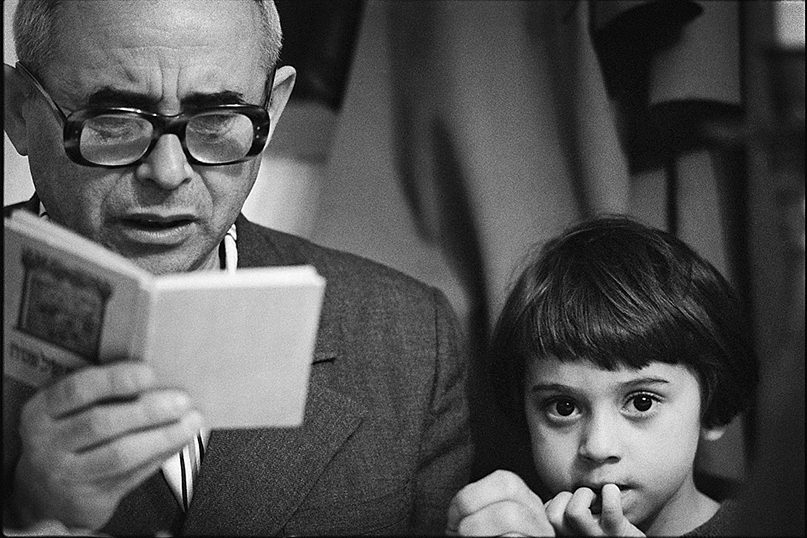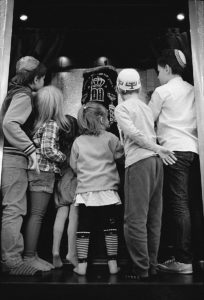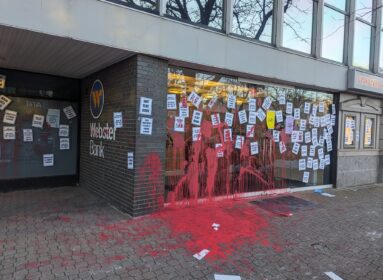
By Stacey Dresner
HARTFORD – During his long career, Chuck Fishman has photographed prominent figures like Pope John Paul II, Anwar Sadat, Fidel Castro, Jackie Kennedy, and Muhammad Ali. His photographs have graced the covers of Time magazine, Fortune and Newsweek.
But back in 1975, as a young photography student, Fishman began work on a photography project that would become one of his most meaningful – photos of the last remnants of the Jewish community in Poland, which had been all but decimated during the Holocaust. He went back several times in the 1970s and ‘80s, when the country was still under Communist rule, to document the tiny Jewish community in Krakow, whose members practiced Judaism secretly, if at all.
In 2013, Fishman returned to Poland with his camera. But this time, several years after the fall of communism, his lens found a vibrant Jewish community in Krakow, with an active Jewish community center, seven synagogues and Jews, young and old, openly celebrating Jewish culture.
The resulting photos are a part of “Regeneration: Jewish Life in Poland, 1975-2018,” an exhibit at Trinity College Hillel’s Zachs Hillel House from Oct. 17 – Nov. 8. Chuck Fishman will be on hand at the opening reception on Thursday, Oct. 17 from 5-7 p.m. The exhibit is co-sponsored by the Greater Hartford Jewish Historical Society and Jewish Hartford European Roots.
Lisa Kassow, director of Trinity College Hillel, got a chance to see “Regeneration” while on a study tour to Poland and Lithuania last July sponsored by the Jewish Historical Society of Greater Hartford. Her husband, Dr. Sam Kassow, a history professor at Trinity, served as the scholar-in-residence on the trip. Kassow is a consultant to the Museum of the History of Polish Jews in Warsaw, another factor in the growing interest in Jewish history and culture in Poland.
The group saw Fishman’s exhibit at the Galicia Jewish Museum in Krakow’s historic Jewish district of Kazimierz.
“[Chuck Fishman] cares so much about people and he cares so much about this story of Jewish life in Poland. And you feel it in the pictures. And so I was so excited that this exhibit was there. I was really impressed. It was very poignant and tells a beautiful story,” says Lisa Kassow, who was familiar with Fishman’s work for many years.
That story began more than 1,000 years ago when Jews arrived in Poland in the 10th century and which over the next centuries became the largest Jewish population in the world. When World War II began, there were 3.5 million Jews in Poland, making up 10 percent of the country’s population. By the end of the war it is estimated that there were perhaps 50,000 to 100,000 surviving Polish Jews.
In 1975, Fishman, a student at Southern Illinois University at the time, went to Poland to take photos for his senior photography project. Rabbi Earl Vinecour, the rabbi at Southern Illinois Hillel was a writer and the two decided to go to Poland and work on the project together with Fishman taking the photos and Rabbi Vinecour writing the text.
Those first photos from 1975 include shots of Jews in their everyday lives.
The black-and-white photos are stark – men playing chess in a Jewish men’s club in Lodz; a kosher butcher washing chicken; a poor elderly Jew waiting for the kosher kitchen to open; a few men surreptitiously holding a Shabbat service. Many of his subjects were Holocaust survivors and several of them pulled up their sleeves so that Fishman could photograph their tattoos.
“You are seeing pictures of an absolutely decimated community,” says Lisa Kassow. “The survivors who stayed throughout the decades of communism had very difficult lives and of course during communism there was no Jewish life that was above board. It was all underground.”
Fishman says he realized he was photographing the last remnants of the once large Polish-Jewish community.
“I said, ‘I’m doing this for myself, for history.’ Because as everyone kept saying, ‘It’s the end! It’s the end!’ [I thought] ‘I’m doing it for when everyone is gone and maybe when I’m gone too, and maybe somebody will appreciate it,’” he recalls.
In 1977, those first photos became the book, Polish Jews: The Final Chapter.
Fishman returned to Krakow four more times when he was working on other photo assignments in Europe and he continued to take photographs of the Jews of Krakow. He always took these photos “very quietly without any official government knowledge.”
Ten years later communism fell and the Jewish community went through a rebirth or “return to identity” as Fishman calls it.
When he went back to Krakow in 2013, he was stunned.
“I was completely over the top floored. All of it was different – everything. When I left what was People’s Republic of Poland was now a western country…or at least when I hit Warsaw, I thought, ‘Wow, this is an international city!’”
The Jewish community in Krakow had also changed.
“Discovering a new Jewish community was just mind-boggling,” he says. “There’s synagogues, there’s JCCs. There’s an awakening of a population and people who are interested, even non-Jewish Poles, who have become, and are still becoming highly interested in Poland’s history, which means the history of the Jews in Poland as well. There are people in small towns who have come to the realization that 35 percent of their town was Jewish before the war and under 50 years of communism they knew absolutely nothing about it. So there’s an uncovering.”
Both the earlier photos of the Jews of Poland and the newer ones of the revived community are included in “Regeneration.” Fishman took all of his photos using black and white film so that they would be visually consistent. The newest photos are being seen publicly for the very first time in the exhibit.
After leaving the Galicia Jewish Museum, the exhibit was set to travel to Daemen College in Buffalo, N.Y., then Georgetown University in Washington, D.C. as part of a tour sponsored by the Poland Ministry of Foreign Affairs.
When Lisa Kassow was told by the Galicia Museum director that the photos would be put into storage for a few weeks between those two exhibits, she and Jewish Historical Society Director Estelle Kafer, also on the trip, jumped at the chance to bring the exhibit to Hartford.
Besides the Poland Ministry of Public Affairs, the exhibit’s community sponsors are the Jewish Federation of Greater Hartford, the Mandell JCC, Voices of Hope, HERO Center, the Trinity College Program of Jewish Studies, and the Trinity College Office of Spiritual and Religious Life.
Fishman calls the work he did on Regeneration “personal.”
“Photographing a pope is not personal. Photographing a president is not personal,” he notes. “But the Polish Jews always took on a feeling that I was doing this for me and for history.”
“Regeneration: Jewish Life in Poland, 1975-2018,” will open Oct. 17, be on display at Zachs Hillel House, 121 Allen Place, Hartford, Monday-Friday, Oct. 17-Nov., 8 1-5 p.m. Opening: Oct. 17, 5-7 p.m.
Special Event: “Visual Reflections: Jewish Hartford European Roots in Poland and Lithuania,” Monday, Nov. 4 at Zachs Hillel House, 5:30-7:30 p.m.
For more information, email lisa.kassow@trincoll.edu.
Main Photo: A man and his grandchild in shul.







 Southern New England Jewish Ledger
Southern New England Jewish Ledger
















